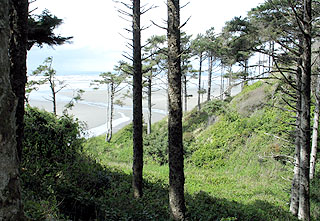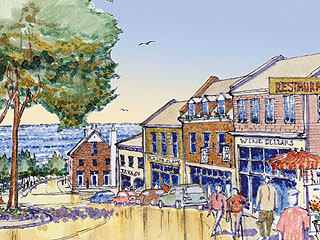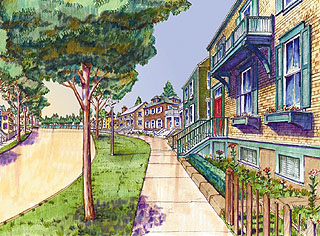
DJC.COM
October 6, 2005
How to build a town from scratch
Special to the Journal

Photo courtesy Seabrook Land Co.
Seabrook residents can walk along a path down this bluff to the beach. The bluff also functions as a buffer against tsunamis.
|
A new town on a bluff overlooking the Pacific Ocean is rising out of the forest on the Washington coast.
Seabrook is not just another housing development with a marketing scheme claiming to be a town. When it is completed, it truly will feel, look and function as a community, as an authentic Northwest town.
The making of American towns
Americans have a rich history of designing and building new cities, towns and villages from the Atlantic to the Pacific. Yet in the latter half of the 20th century, Americans virtually forgot the art and science of designing and building new towns. Now again, Americans in recent decades have been returning to the urban neighborhoods, main streets, small towns and villages that have been so much a part of our heritage.
The Pilgrims settled around the Commons carved out of New England's primordial forests. The Founding Fathers designed Washington, D.C., with a civic grandeur befitting their vision of a new nation. Railroad engineers platted new grid towns along the tracks. Architects designed works of true civic art such as Chicago and its outlying communities. Industrial magnates built whole new company towns such as Kohler, Wis., and Longview, Wash., not only to house workers but to establish new communities and new societies.
In all these instances, Americans learned from the best traditions of past city builders as they envisioned their future towns and cities.
Suburban sprawl
In past decades Americans nearly forgot the art and science of designing new towns. The second half of the 20th century saw an unprecedented expansion of auto-dominated suburbs, commercial strips and big-box shopping centers, mono-cultures of single-use office parks, apartment complexes, gated-communities and McMansion sprawl. No wonder new development is so often met with community opposition.
These new suburbs were fundamentally different from the traditional urban neighborhoods that preceded them. Zoning laws, first used to separate the most noxious industries in the midst of residences, eventually were misused to segregate uses that really did not need to be apart. Stores were zoned far away from houses, instead of in the neighborhood center within walking distance. Offices were zoned to outlying office parks instead of above the stores on Main Street. Even residences were zoned into separate pods according to density, resulting in de facto segregation by income and age.
With everything zoned apart from everything else, the need to drive for almost everything became the norm.
There were many other forces at play that gave us the suburban sprawl now encasing nearly every town and city in the nation. Whether the building industry's tendency for housing standardization, the transportation planner's focus on auto arterials versus public transit, the bank's reluctance to fund mixed-use development — the complex causes of suburban sprawl have been well documented by critics.
Return to small towns

Drawing by Laurence Qamar/Seabrook Land Co.
Seabrook’s Main Street opens out to the Pacific through a forested glen.
|
We are witnessing in recent years a return to the time-tested towns, villages and urban neighborhoods of past generations throughout the country and especially here in the Pacific Northwest.
In Portland, Seattle and Vancouver, old neighborhoods and main streets are being revitalized. Downtown housing infill and compact mixed-use development are invigorating the urban cores and outlying neighborhood centers. Developers are pulling the roofs off of shopping centers, connecting them to nearby neighborhoods, and making them walkable main streets reminiscent of bygone downtowns.
But when was the last time you heard of someone designing and building a complete, authentic new town from the ground up?
Making it real
Seabrook is that new town! Perched on an 80-acre bluff overlooking two streams and the Pacific Ocean, Seabrook is rising. It is located near Pacific Beach, until recently a sleepy ocean side town in Grays Harbor County.
What will make Seabrook look, feel and function as a real town?
Seabrook's master plan is designed with the principles of underlying villages and towns throughout time. Seabrook's special zoning code allows for living, shopping, recreating and working all within a short walk of one another. A network of sidewalks, paths and trails are designed to promote walking and biking.
There will be parks, greens, squares, park pavilions and a small main street where people can gather and meet their neighbors. It has a tight network of traffic-calmed streets that are attractive and inviting public places, not wide thoroughfares.
The town is designed to embrace its surrounding natural environment and to gather people closer to its heart. It is completely open to the public, not an exclusive gated community. A necklace of parks encircles the town with a promenade running along the ocean bluff between the town and the Pacific. The streets and greenways all flow out to this high promenade and down to the beach, making ocean access and views available to everyone.
Conventional developers often wall off such a beautiful natural amenity to the public by privatizing all its frontage for the benefit of only a few. But at Seabrook, as in the old Oregon coastal town of Cannon Beach, all the lanes connect perpendicular to the beach — extending the value of the ocean deep into the town.
Diverse, unique design
Seabrook's 400 units are concentrated onto a relatively small footprint of 50 acres with an additional 30 acres of parks and greenways. Instead of stringing out these units along the water's edges, the town's center is located several hundred feet from the beach. The result is a rich, wind blown, forested bluff preserve overlooking the beach and Pacific Ocean.
Like any authentic town, Seabrook embraces diversity and uniqueness. Rather than segregate different housing types and densities into distinct gated enclaves, Seabrook will have large and small lot houses, townhouses, apartments and live/work houses graduated from the town edge to town center. Rear lanes will service nearly all of Seabrook's houses, enabling the street fronts and greenways to be lined by vibrant and lively houses, not garage doors.
The architectural character is intentionally diverse, too. While about 70 percent of the houses are designed and built by the Seabrook companies, every effort is made to ensure that they express both the stylistic variety and continuity found in a town that grew up over time. The remaining 30 percent of lots are sold as founders lots for those buyers who want to choose a pre-approved architect to design their own custom house. The result is an assurance of quality and value.
Seabrook is meeting a market desire for young family second homes, empty nesters and the growing number of remote Internet-based businesses who choose quality of life over proximity to the office park or downtown.
The small town of Pacific Beach just up the road from Seabrook is also experiencing recent revitalization. Residents are fixing up their houses and main street storefront. New cottages are being built on previously vacant lots. The citizen-run business association raised funds to build a gazebo at the end of main street overlooking the Pacific. A new downtown revitalization effort initiated by the citizens, supported by the county and facilitated by outside experts is under way. Pacific Beach, too, is rising.
Sustainability, livability

Drawing by Laurence Qamar/Seabrook Land Co.
Houses are close to the street, with garages in back.
|
Why build and revitalize villages, towns and urban neighborhoods? The benefits are twofold: sustainability and livability.
If development is zoned to occur in a region, then the compact, walkable and mixed--use qualities of towns are far more ecologically sustainable compared to the lower density, auto-oriented, mono-cultures of conventional suburbia.
There is an unmet market demand for livable communities here in the Northwest and throughout the nation. Americans are once again returning to the traditional towns and urban neighborhoods of their forefathers.
For more information, visit www.seabrookwa.com.
Laurence Qamar, AIA, is a town planner and urban designer based in Portland. He has planned new towns, downtown redevelopments, urban neighborhood restorations and transit-oriented town centers throughout the country. He is the architect/town planner for Seabrook.
Other Stories:
- Giving downtown Enumclaw a sense of place
- 5 mega-trends for Puget Sound real estate
- Can Pioneer Square-Stadium District be energy self-sufficient?
- GMA's success depends on local actions
- Finding a home for young urban workers
- Victoria project's goal: 26 LEED platinum buildings
- After Katrina, the chance to build a better city
- Seattle checks into the hotel-condo market
- Everett charts a new waterfront neighborhood
Copyright ©2009 Seattle Daily Journal and DJC.COM.
Comments? Questions? Contact us.